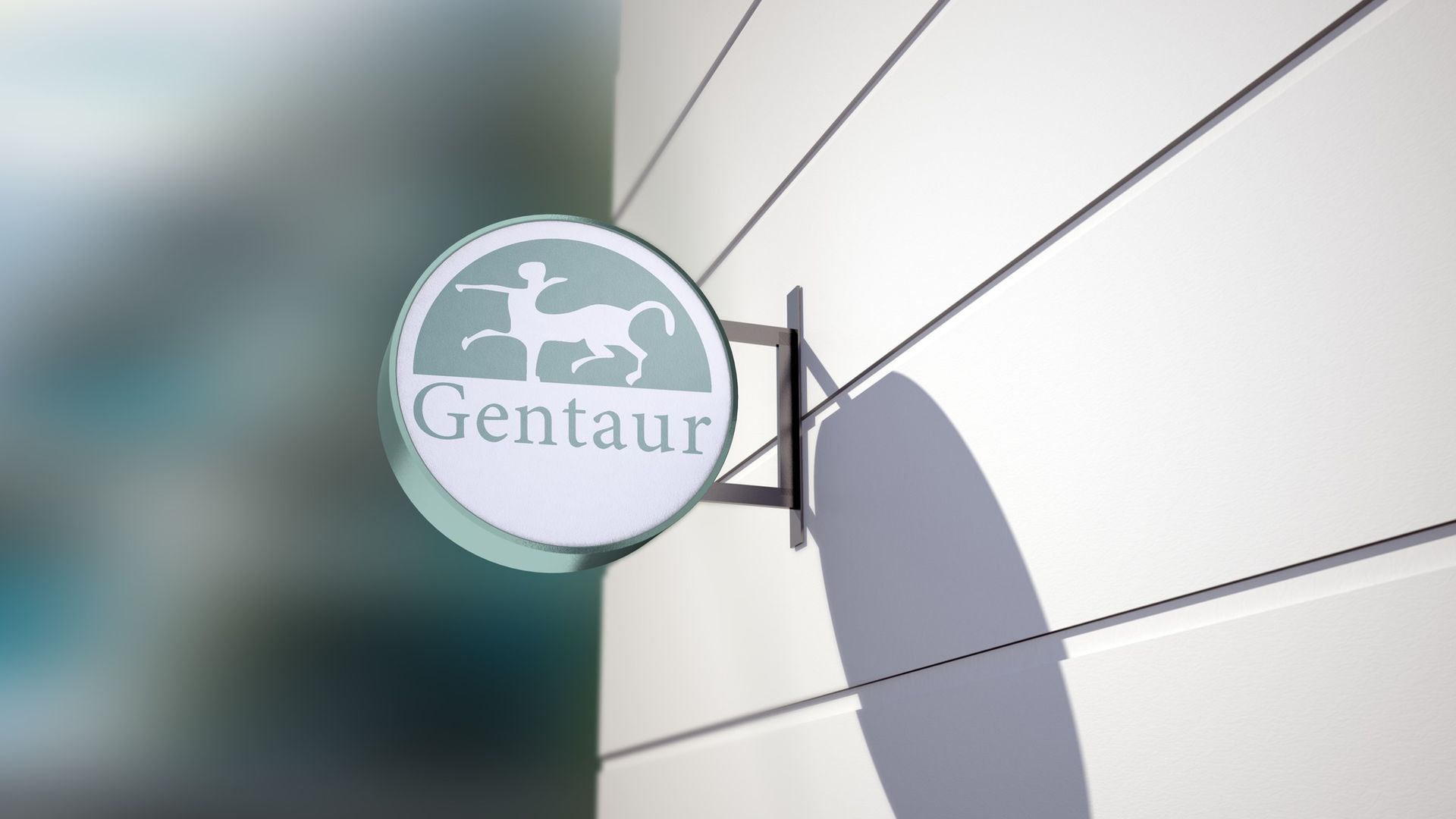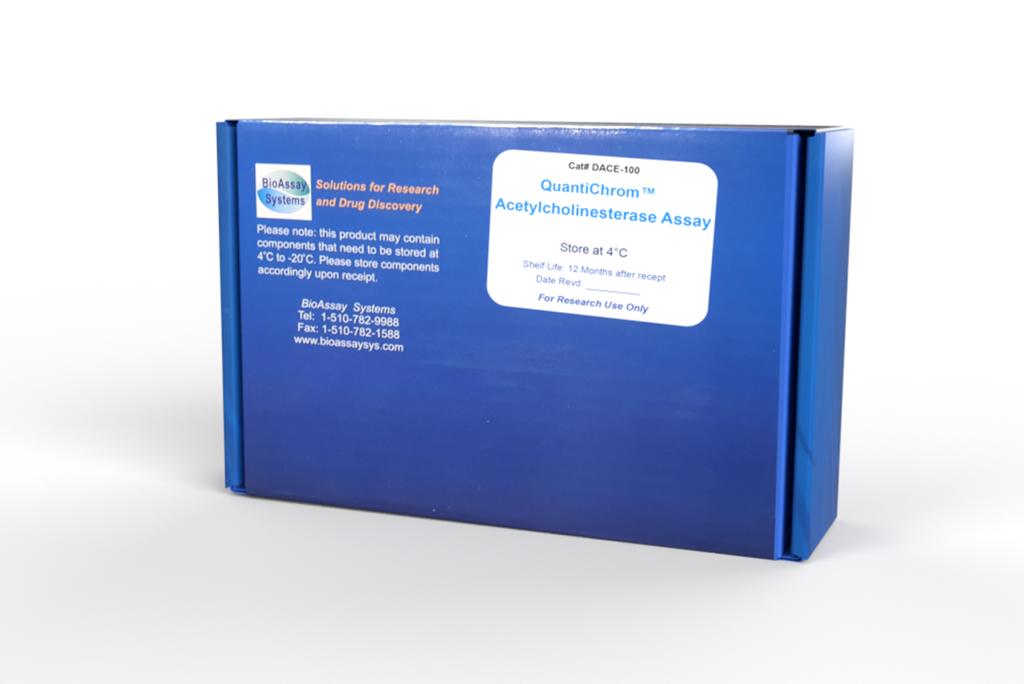DESCRIPTION
ACETYLCHOLINESTERASE (EC 3.1.1.7, AChE), also known as RBC cholinesterase, is found primarily in the blood and neural synapses. Low serum cholinesterase activity may relate to exposure to insecticides or to one of a number of variant genotypes. AChE catalyzes the hydrolysis of the neurotransmitter acetylcholine into choline and acetic acid, a reaction necessary to allow a cholinergic neuron to return to its resting state after activation. Cholinesterase levels of cells and plasma are used as a guide in establishing safety precautions relative to exposure and contact, as well as a guide in determining the need for workers to be removed from areas of contact with the organic phosphate insecticides.
Simple, direct and automation-ready procedures for measuring AChE activity are very desirable. BioAssay Systems' QuantiChromTM Acetylcholinesterase Assay is based on an improved Ellman method, in which thiocholine produced by the action of acetylcholinesterase forms a yellow color with 5,5’-dithiobis(2-nitrobenzoic acid). The intensity of the product color, measured at 412 nm, is proportionate to the enzyme activity in the sample.
APPLICATIONS
Direct assays of acetylcholinesterase activity in blood, serum, plasma, and other biological samples. Evaluation of acetylcholinesterase inhibitors.
KEY FEATURES
Sensitive and accurate. Detection range 10 to 600 U/L AChE activity in 96-well plate assay. Convenient. The procedure involves adding a single working reagent, and reading the optical density at 2 min and 10 min at room temperature. High-throughput. Can be readily automated as a high-throughput 96- well plate assay for thousands of samples per day.
KIT CONTENTS (100 tests in 96-well plates)
Storage conditions. The kit is shipped at room temperature. Store all reagents at room temperature. Shelf life: 6 months after receipt. Precautions: reagents are for research use only. Normal precautions for laboratory reagents should be exercised while using the reagents. Please refer to Material Safety Data Sheet for detailed information.
PROCEDURES
Sample preparation. Blood samples should be diluted 40-fold in the Assay Buffer, e.g. accurately pipet 5 µL blood and mix thoroughly with 195 µL Assay Buffer.
Tissue or cell lysates are prepared by brief sonication or homogenization in 0.1M phosphate buffer (pH 7.5), followed by centrifugation at 14,000 rpm for 5 min. Use supernatant for assay. Ideally samples should be assayed fresh. If this is not possible, refrigerate samples and assay them within 24 hours.
Reagent preparation: the Working Reagent should be prepared freshly and used within 30 min. Each reaction well requires 2 mg reagent. Calculate the amount of reagent needed and weigh this amount (mg) in a centrifuge tube. Add 200 µL Assay Buffer per 2 mg reagent. Vortex to dissolve.
1. Calibrator: transfer 200 µL water and 200 µL calibrator separately into wells of a clear bottom 96-well plate. Samples: add 10 µL sample per well in separate wells.
2. Reaction: transfer 190 µL freshly prepared Working Reagent to all sample wells and tap plate briefly to mix. Read OD412nm at 2 min and at 10 min in a plate reader.
3. Calculation: acetylcholinesterase activity is calculated as follows,
Where OD10 and OD2 are the OD412nm values of the sample at 10 min and 2 min, respectively. ODCAL and ODH2O are the OD412nm values of the Calibrator and water at 10 min. n is the dilution factor (n = 40 for whole blood). The number “200” is the equivalent activity of the calibrator under the assay conditions.
Note: if the AChE activity without consideration of the dilution factor is higher than 600 U/L, dilute sample further in Assay Buffer and repeat the assay. Multiply the results by the dilution factor.
Unit definition: one unit of enzyme catalyzes the production of 1 µmole of thiocholine per minute under the assay conditions (pH 7.5 and room temperature).
MATERIALS REQUIRED, BUT NOT PROVIDED
Pipeting (multi-channel) devices. Clear-bottom 96-well plates (e.g. Corning Costar) and plate reader.
GENERAL CONSIDERATIONS
1. This assay is based on an enzyme-catalyzed kinetic reaction. Addition of Working Reagent should be quick and mixing should be brief but thorough. Use of a multi-channel pipettor is recommended.
2. For assays in standard 1 mL cuvet, use 1 mL water and 1 mL Calibrator, 50 µL sample + 950 µL Working Reagent.
EXAMPLES
Two human blood samples were assayed in duplicate using the 96- well plate protocol. The AChE activities were 3,402 ± 163 and 3,660 ± 151 U/L
PUBLICATIONS
1. Ketenci, S. et al (2020). The neurochemical effects of prazosin treatment on fear circuitry in a rat traumatic stress model. Clinical Psychopharmacology and Neuroscience, 18(2), 219-230.
2. Hafiz, Z. Z., et al (2020). Inhibitory effects of raw-extract centella asiatica (Reca) on acetylcholinesterase, inflammations, and oxidative stress activities via in vitro and in vivo. Molecules (Basel, Switzerland), 25(4).
3. Voorhees, J. R., et al (2019). Occupational-like organophosphate
exposure disrupts microglia and accelerates deficits in a rat model
of Alzheimer 's disease. NPJ Aging and Mechanisms of Disease,
5, 3.

